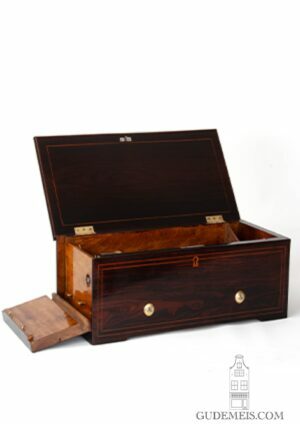A large Swiss ‘bells and drum’ cylinder music box, Rivenc, circa 1880.
Description
Cylinder music boxes
The first cylinder music boxes were created early in the nineteenth Century. First the teeth were screwed down separately but soon larger ‘combs’ were made. During the second quarter of the Century the combs were perfected and the quality of the sound became better and better. The makers didn’t stop at that point and started to experiment with other inventions that would make the music boxes better and more attractive. After the middle of the Century some makers started to add bells, drum, castanets and even organs to sound next to the comb. These accessories were also attractive to look at when playing. With a music box being an object to impress others with its sound, it now became a visual spectacle as well for the 19th century beholder. This grand piece still has the attraction this day through its beautiful grand case and wonderful playing motion and sound.
The mechanism
The brass mechanism is driven by a spring barrel with a fixed winding handle. it plays one of ten airs with a 38-cm pinned cylinder on two combs, a drum and six saucer bells in vue. There are levers for start/stop and change/repeat.
The box
The rectangular box has a moulded ebonized lid with kingswood crossbanded veneered borders and flower marquetry inlay. There are well cast brass handles to the sides. The moulded plinth is raised on flat feet.
Tune sheet
On the inside of the lid is the tune sheet listing the airs.
Tambour, Timbres.
1. So wie du Walzer
2. Il Trovatore Coro di Zingari
3. Le Carnaval de Venise
4. Lonange aux Femmes Mazurka
5. Marche de Tannhauser
6. Valse de Faust
7. Le Barbier de Séville C ne de Figaro
8. Guillaume Tell Cyrolienne
9. L’Etudiant Polka
10. La Fille de Mad. Angot Choeur





















